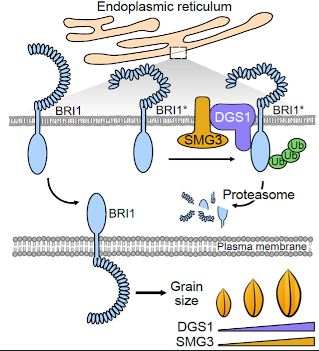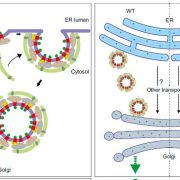The system that monitors protein folding status regulates grain size
Li and Zhang et al. explore the involvement of ERAD in grain size regulation.
Jing Li; University of Chinese Academy of Sciences, Beijing, China.
Ran Xu; Sanya Nanfan Research Institute of Hainan University, Sanya, China
Background: Grain size affects yield and is therefore an important agronomic trait, but our knowledge about the molecular and genetic mechanisms regulating grain size remains limited. Endoplasmic reticulum (ER)-associated degradation (ERAD) is a special ubiquitin proteasome system, which constantly monitors the folding status of secretory and membrane proteins and degrades irreparable terminally misfolded proteins. Several ERAD components are known to play critical roles in multiple biotic and abiotic responses, but whether ERAD acts in regulating grain size remains unknown.
 Question: Does ERAD participate in grain size regulation? What is the detailed mechanism behind it?
Question: Does ERAD participate in grain size regulation? What is the detailed mechanism behind it?
Findings: Here we identified an ERAD-related E2-E3 enzyme pair, SMALL GRAIN 3 (SMG3) and DECREASED GRAIN SIZE 1 (DGS1), that regulate grain size and weight through the brassinosteroid (BR) signaling pathway in rice (Oryza sativa). Loss of function of SMG3 or DGS1 results in small grains, while overexpression of SMG3 or DGS1 leads to long grains. DGS1 ubiquitinates the BR receptor BRI1 and affects its accumulation. Genetic analysis suggests that SMG3, DGS1 and BRI1 act together to regulate grain size. Thus, our findings give insight into the function and molecular mechanism of ERAD in grain size control, and establish a direct molecular connection between ERAD and BR signaling.
Next steps: We will further investigate whether SMG3 and DGS1 are also involved in stress responses in rice, and how ERAD coordinates stress responses and grain size control.
Reference:
Jing Li, Baolan Zhang, Penggen Duan , Li Yan, Haiyue Yu, Limin Zhang, Na Li , Leiying Zheng, Tuanyao Chai, Ran Xu, and Yunhai Li. (2023). An ERAD-related E2-E3 enzyme pair controls grain size and weight through the brassinosteroid signaling pathway in rice. https://doi.org/10.1093/plcell/koac364





